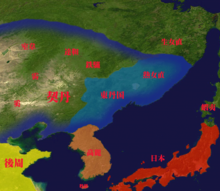Dongdan Kingdom
Dongdan Kingdom 東丹 | |||||||||
|---|---|---|---|---|---|---|---|---|---|
| 926–936 | |||||||||
| Capital | Huhan | ||||||||
| Common languages | Khitan language, Goguryeo language | ||||||||
| Religion | Buddhism, Taoism, Confucianism and Shamanism | ||||||||
| Government | Monarchy | ||||||||
| History | |||||||||
• Established | 926 926 | ||||||||
• Annexed by the Liao dynasty | 936 936 | ||||||||
| |||||||||
| Today part of | China North Korea Russia | ||||||||

The Dongdan Kingdom (926–936) (simplified Chinese: 东丹; traditional Chinese: 東丹; Khitan language: Dan Gur,[1]) was a puppet kingdom established by the Liao dynasty to rule the former realm of Balhae (Bohai) in eastern Manchuria.[2]
History[edit]
After conquering Balhae (Bohai) in 926, the Liao crown prince Yelü Bei ascended to the throne of Dongdan at the Huhan fortress, the former capital of Balhae, in today's Mudanjiang, Heilongjiang Province. The state used Dongdan as its Chinese name, meaning the Eastern Dan Gur (Bohai), in respect to the Liao dynasty in the west.[3] The term Dongdan is only found in Chinese texts; the Khitan equivalent is "Dan country" (Dan Gur), similar to Silla's and Goryeo's use of the word "Dan" 丹 as a derogatory term for the states and people of Manchuria.[4]
However, political tension soon evolved between Yelü Bei and his younger brother Yelü Deguang, who took the imperial throne of the Liao dynasty after their father Yelü Abaoji died, en route to his homeland from a relatively successful campaign against the Later Tang. The new emperor ordered his elder brother to move his capital from Huhan in eastern Manchuria to Liaoyang in western Manchuria.
Yelü Bei obeyed the imperial order but soon fled to North China to avoid possible assassination in 930. Yelü Bei's son was elevated to the new king of Dongdan, but the kingdom was annexed by the Liao dynasty in 936.[5] A minority of historians suggest Dongdan was annexed in 982. On the other hand some believe that Dongdan was never a "independent kingdom", but the former area of Balhae was instantly annexed in 926 by the Liao dynasty.[6]
To continue Balhae's friendly relations with Japan, Dongdan sent a diplomatic mission over the Sea of Japan in 929. But the Japanese court in Kyoto rejected the mission from Dongdan, due to loyalty for the old Balhae regime.[7]

See also[edit]
Notes[edit]
- ^ 契丹文dan gur本義考 あわせて「東丹国」の国号を論ず[permanent dead link]
- ^ 이이화의 〈한국사 이야기 4-남국 신라와 북국 발해〉
- ^ 徐俊. 中国古代王朝和政权名号探源. 湖北武昌: 华中师范大学出版社. 2000年11月: 262. ISBN 7-5622-2277-0.
- ^ Pamela Kyle Crossley (2016). "Bohai/Parhae Identity and the Coherence of Dan gur under the Kitan/Liao Empire". International Journal of Korean History. 21 (1): 11–44. doi:10.22372/ijkh.2016.21.1.11.
- ^ 徐俊. 中国古代王朝和政权名号探源. 湖北武昌: 华中师范大学出版社. 2000年11月: 262. ISBN 7-5622-2277-0.
- ^ SAWAMOTO, Mitsuhiro (2008). "The Kitai Dynasty's governance of Bohai and the structure of Dongdanguo as seen from Yelu-Yuzu's Epitaph". Shigaku Sawamoto Mitsuhiro Zasshi. 117 (6): 1097–1122. doi:10.24471/shigaku.117.6_1097. ISSN 0018-2478.
- ^ The Kitai Dynasty’s governance of Bohai and the structure of Dongdanguo as seen from Yelu-Yuzu’s Epitaph
